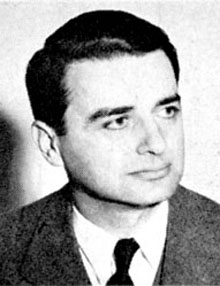 EDWIN LAND
EDWIN LAND| Erasmus Bartholin (1625-1698) was sent, in 1669, a transparent crystal from Iceland (Iceland spar) and, by rotating the crystal, he discovered that objects seen through it appeared double. He correctly deduced that light traveling through the crystal was refracted at two different angles. Today, these are still called the ordinary and extraordinary rays. The explanation required the genius of Thomas Young (1773-1829) to account for them some 150 years later: the two rays were polarized at right angles to each other. William Nicol (1768-1851) had the ingenious idea of cementing two crystals of Iceland spar together with Canada balsam so that each ray was separated at right angles. The resulting Nicol prism could then be used to measure the angle of polarization of compounds, which later resulted in a profound understanding of many aspects of chemistry. Today, Nicol prisms are still very expensive, bulky and of limited aperture. Edwin Land, when a Harvard freshman, conceived the idea that a polarizer might be made by lining up a myriad of tiny crystals (iodoquinine sulphate) in the same direction and embedding them in transparent plastic which, when set, prevented the crystals from drifting apart. The new polarizer was patented in 1929. | |
 | The conventional photographic process involves exposing light sensitive material, which in turn must be developed, fixed, printed and the print developed and fixed, a procedure which can take hours, (or days if the processing facility is far from the place where the photo was taken.) In 1947, a remarkable new system of developing and taking pictures was introduced by American physicist Edwin Herbert Land (1909-1991). |
| Land had left Harvard after his freshman year to conduct his own research on the polarization of light. Two years later, he invented a sheet polarization filter which could be used on camera lenses to eliminate reflection and glare. In 1937, Land founded the Polaroid Corporation to manufacture and market his filters, lamps, window shades and sunglasses.In February 1947, he introduced Polaroid (po’lar-oid) instant film for use in his own Polaroid Land Camera. The Land camera (patent #2,543,181) was first offered for sale on November 26th, 1948. Polaroid film processes chemicals in a flat, hermetically sealed compartment attached to the photosensitive paper. A pair of pressure rollers spreads the chemicals uniformly across the paper when exposed, and the completed print is ready a minute later. In 1963, Land introduced Polacolor, a full color film, which could be processed in less than a minute. In 1972, the "SX-70" replaced the wet, peel-apart development process with dry films that developed in light. (Land even created an instant color movie-making system, "Polavision," in 1978; but this never enjoyed the commercial success of his still-photography cameras.) | |


